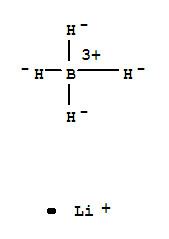Formula LiBH4 Density 666 kg/m³ Melting point 275 °C | Molar mass 21.784 g/mol Boiling point 380 °C Appearance White solid | |
 | ||
Car parrinello study of li ion diffusion in lithium borohydride
Lithium borohydride (LiBH4) is a tetrahydroborate and known in organic synthesis as a reducing agent for esters. Although less common than the related sodium borohydride, the lithium salt offers some advantages, being a stronger reducing agent and highly soluble in ethers, whilst remaining safer to handle than lithium aluminium hydride.
Contents
- Car parrinello study of li ion diffusion in lithium borohydride
- Preparation
- Reactions
- Chemoselectivity
- Hydrogen Generation
- Energy storage
- References
Preparation
Lithium borohydride may be prepared by the metathesis reaction, which occurs upon ball-milling the more commonly available sodium borohydride, and lithium bromide:
NaBH4 + LiBr → NaBr + LiBH4Alternatively it may be synthesized by treating boron trifluoride with lithium hydride in diethyl ether:
BF3 + 4 LiH → LiBH4 + 3 LiFReactions
Lithium borohydride is a stronger reducing agent than sodium borohydride. In mixtures of methanol and diethyl ether, lithium borohydride is able to reduce esters to alcohols and primary amides to amines. In contrast, these substrates are unaffected by sodium borohydride. The enhanced reactivity is attributed to the polarization of the carbonyl substrate by complexation to the lithium cation.
Chemoselectivity
The use of lithium borohydride is particularly advantageous in some preparations due to its higher chemoselectivity relative to other popular reducing agents such as lithium aluminium hydride. For instance, unlike lithium aluminium hydride, lithium borohydride will reduce esters, nitriles, lactones, primary amides, and epoxides while sparing nitro groups, carbamic acids, alkyl halides, and secondary/tertiary amides.
Hydrogen Generation
Lithium borohydride reacts with water to produce hydrogen. This reaction can be used for hydrogen generation.
Energy storage
Lithium borohydride is renowned as one of the highest energy density chemical energy carriers. Although presently of no practical importance, the solid will liberate 65 MJ/kg heat upon treatment with atmospheric oxygen. Since it has a density of 0.67 g/cm3, oxidation of liquid lithium borohydride gives 43 MJ/L. In comparison, gasoline gives 44 MJ/kg (or 35 MJ/L), while liquid hydrogen gives 120 MJ/kg (or 8.0 MJ/L). The high specific energy density of lithium borohydride has made it an attractive candidate to propose for automobile and rocket fuel, but despite the research and advocacy it has not been used widely. As with all chemical-hydride-based energy carriers, lithium borohydride is very complex to recycle (i.e. recharge) and therefore suffers from a low energy conversion efficiency. While batteries such as lithium ion carry an energy density of up to 0.72 MJ/kg and 2.0 MJ/L, their DC to DC conversion efficiency can be as high as 90%. In view of the complexity of recycling mechanisms for metal hydrides, such high energy conversion efficiencies are beyond practical reach.
